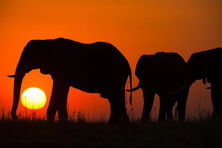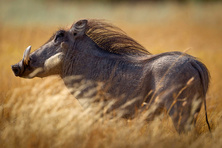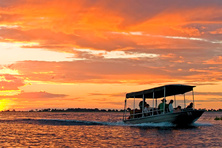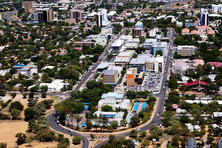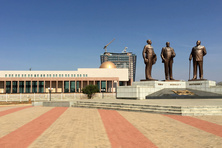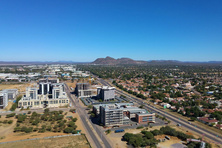Botswana
- Capital:Gaborone
- Currency: Botswana pula
- Time: UTC+2
- Languages: Setswana, English
- Religions: Christianity (Anglicanism, Methodism, the adherents of the Joint congregational church of South Africa)
- Sections: Get in Visa Customs Cuisine Money Details of interest Popular resorts
Botswana or officially known as the Republic of Botswana is a state in the southern part of the African Continent. It borders Namibia, Zambia, South Africa, and Zimbabwe. Gaborone serves as the capital city of the country.
The country has a sub-tropical climate. The lovers of nature should come to Botswana in a wet season from November to April to watch rare birds. This is also the most favourable season for visiting the Kalahari desert. The best time for safari is from May to October.
The official languages are Tswana and English. The major religion is the Christianity.
Due to its unusual and diverse nature, Botswana is the main destination for the ecological tourism. Excursions to the Okavango Delta and Moremi Game Reserve and the Central Kalahari Game Reserve with its caves are arranged for the tourists. Those who like the natural sights should go hiking to the Makgadikgadi Depression. There, anyone can see the local lakes and the Makgadikgadi swamp.
The fans of extreme tourism can go to water or land safari in the Chobe National Park. The same tours are arranged by the Safari-camp Linyanti on the Linyanti river which meets the Chobe river.
A small city of Kasane is a wonderful country resort where one can enjoy the quietness and go fishing.
In Gaborone, there are all you need for yachting and windsurfing. The tourists can have a walk in the parks. In the capital city, you can do the shopping in the malls.
Get in
By Plane
There are no direct flights from CIS and EU countries to Botswana. The travel to Botswana from Russia, Ukraine, and Belarus requires, at least, two transfers in Istanbul, Dubai, Munich, and Johannesburg.
British Airways, Air Botswana, and Kenya Airways offer flights from London to Gaborone with a transfer in Nairobi or Johannesburg. Ethiopia and Air France offer transit flights from Paris to Botswana. And Lufthansa, South African, and Air Botswana fly from Berlin.
By Train
Two times a week, there is a train running from Zimbabwe to Bulawayo and Francistown.
By Sea
There is a ferry route between Botswana and Zambia. We recommend learning the schedule of the ferry beforehand.
By Land
One can get to Botswana by car from all the neighbouring countries.
Visa
The travellers from the EU and the Russian Federation can travel to Botswana and stay there for 90 days visa-free. When crossing the border, the tourists should provide an international passport valid for, at least, six months. Anyone can extend their permit to stay in the country applying to the Immigration Office in the capital city.
The citizens of other CIS countries must obtain a visa to get to Botswana submitting the documents to the Embassy of Great Britain.
It usually takes 10 working days to get a visa and it stays valid for a month.
Customs
The Customs legislation of Botswana does not have any restrictions concerning the import of foreign currency. But be aware that any sum of money must be declared. One can bring in the national currency without any restrictions, but the export of the national currency is limited to 5.000 Botswana pulas (BWP).
The tourists can bring in Botswana the following goods duty-free:
- some alcohol and tobacco;
- personal clothes, shoes and other goods.
It is prohibited to import:
- non-certified meat products;
- plants and food of plant origin (without a permit);
- pets (without an international vet certificate);
- semi-precious gemstones.
The tourists are not allowed to export:
- wild animals, their skins and other hunting trophies;
- unprocessed diamonds;
- non-certified ostrich eggs;
- non-declared polished diamonds.
Cuisine
The Botswana cuisine is very similar to the cuisines of other South African countries, however, it still preserved its authenticity. The staple food in Botswana is maize, sorgo, rice, beans, vegetables, fruits, beef, and fish.
The foodies should definitely try such meat dishes as grilled beef Braaivleis, air-dried meat Biltong, chicken stew Binyani and meat with porridge Seswaa.
If you strive for something more exotic, try Mashonzha. This dish is prepared from caterpillars with peanut butter and red hot pepper. Another exotic dish is Serobe made from goat or sheep pluck.
There are a lot of fish dishes in Botswana.
A thick maize porridge Pap, a porridge Bogobe or fermented corn with milk and sugar Ting are common side dishes.
Any meal is usually served with flatbread Diphaphatha. Try Matemekwane which is kind of pelmeni.
Fruits are served at the end of a meal as a dessert. In Botswana, people also make a fantastic cake Magwinya.
The most popular non-alcoholic drinks are Madila (a sour-milk beverage) and fresh fruit juices.
The local like sorgo or millet beer (Bojalwa), maize beer Chibuku, and an alcoholic drink Khadi.
Money
The official currency in Botswana is the Pula (BWP) which is divided into 100 thebe. The Bank of Botswana issues the banknotes from 10 to 100 pulas and from 5 to 50 thebes.
In some touristic places, Euro and US dollars are accepted, but it is an exception from the rule.
The tourists can exchange the currency at banks, in exchange offices, hotels and at airports. If you prefer country resorts, make sure you have enough cash.
Outside large touristic centres, the tourists can pay only with cash. Credit cards are accepted only in hotels, stores and restaurants in big cities.
You can cash traveller's checks only at banks in the capital city.
Details of interest
Sightseeing in Botswana
In Botswana, there are two UNESCO sites.
- The tourists who love nature, should take a trip along the Okavango Delta which is the largest inner delta in the world without access to the ocean. The waters of the river disappear in the Kalahari Desert. The Okavango Delta is a habitat for the colonies of the white ants, hippopotamus, oxen, elephants, antelopes, and crocodiles. Here, you can watch the kite on the hunt. You will swim in aboriginal pirogues.
- In Botswana, you will have a unique chance to see the remnants of the rock art in the district of Tsodilo which was recognised as a masterpiece of the human creative genius. This is why this district was named the Louvre of the Desert as it contains the biggest amount of the rock art examples. On the territory of 10 square kilometres, there are over 4.500 petroglyphs. As the scientists say, the age of many petroglyphs is about 100.000 years old. The people from the local tribes believe that these places are haunted by the spirits of the ancestors.
The tourists should also visit seven historical and natural UNESCO candidate sites.
- We recommend visiting the Central Kalahari Game Reserve close to the border with the Republic of South Africa. In the desert with the total area of 2.000. 000 Ha, there are a lot of wild animals, eagles, and vultures.
- The Toutswemogala Hill Iron Age Settlement has a great historical value. The ruins of the ancient settlement are located on the top of the hill surrounded by the steppe. According to the archaeologists, this settlement played a very important role in forming early African states.
- The Chobe Linyanti System deserves a special attention. This protected area adjoins the rivers and is divided into four independent ecosystems. The tourists try to visit this place when the rivers are full-flown, they change their course and meet.
- The Gcwihaba Caves have the total area of 2.500 square meters. The stalactites and stalagmites were formed because the water rich in salts penetrated the rocks and due to this fact, the formations have different colours.
Botswana Souvenirs
In Botswana, the tourists usually buy:
- handmade baskets;
- carpets, bed covers, handmade tapestry;
- musical instruments;
- bead jewellery;
- national Bushmen clothes.







